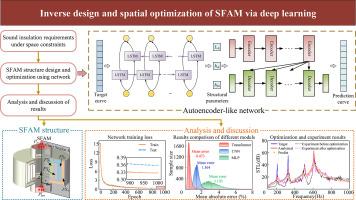基于深度学习的sfm逆设计与空间优化
IF 9.4
1区 工程技术
Q1 ENGINEERING, MECHANICAL
International Journal of Mechanical Sciences
Pub Date : 2025-09-17
DOI:10.1016/j.ijmecsci.2025.110855
引用次数: 0
摘要
管道噪声具有低频和宽带的特点,空间折叠声学超材料(sfm)被提出作为一种解决方案。然而,sfm设计存在效率低、误差大、占用空间大的问题。为了解决这些限制,我们提出了一种串联长短期记忆(LSTM) -变压器自编码器类网络模型用于sfm逆设计。利用Transformer模型特有的位置编码和注意机制,建立了结构尺寸与声学性能之间的精确映射。利用LSTM模型的长期依赖关系,从目标曲线中提取更多的数据隐式特征。将LSTM模型与预训练的Transformer模型串联起来,实现了sfm的精确反设计。通过与卷积神经网络(CNN)、多层感知器(MLP)等传统深度学习网络的比较,揭示了模型内部结构对设计结果的影响。实验结果表明,变压器和LSTM模型串联策略融合了两者的优点,设计结果与目标曲线高度一致。基于多目标优化,综合考虑峰值频率、峰值数量、隔声带宽、空间占用等因素对设计结果的影响。优化后的两种sfam在满足隔声要求的同时,空间占用率分别降低了16.81%和19.39%,为空间受限条件下的声学超材料设计提供了一种高效可行的解决方案。本文章由计算机程序翻译,如有差异,请以英文原文为准。

Inverse design and spatial optimization of SFAM via deep learning
Pipeline noise is characterized by low-frequency and broadband characteristics, for which space-folded acoustic metamaterials (SFAM) have been proposed as a solution. However, the SFAM design suffers from low efficiency, high errors, and high space occupation. To address these limitations, we proposed a tandem long short-term memory (LSTM)–Transformer autoencoder-like network model for SFAM inverse design. An accurate mapping between structural dimensions and acoustic performance was established using the positional encoding and attention mechanism unique to the Transformer model. More data-implicit features were extracted from the target curves, utilizing the long-term dependencies of the LSTM model. The accurate inverse design of SFAM was realized by concatenating the LSTM model with the pre-trained Transformer model. Through comparison with traditional deep learning networks, such as convolutional neural network (CNN) and multilayer perceptron (MLP), the influence of the model internal structure on the design results was revealed. The experimental results show that the Transformer and LSTM model tandem strategy integrates the advantages, resulting in highly consistent design results with the target curve. Based on multi-objective optimization, the design results were optimized to consider the effects of peak frequency, peak quantity, sound isolation bandwidth, and space occupancy. The two optimized SFAMs not only meet acoustic insulation requirements but also reduce spatial occupancy by 16.81 % and 19.39 %, respectively, providing an efficient and feasible solution for designing acoustic metamaterials under space-constrained conditions.
求助全文
通过发布文献求助,成功后即可免费获取论文全文。
去求助
来源期刊

International Journal of Mechanical Sciences
工程技术-工程:机械
CiteScore
12.80
自引率
17.80%
发文量
769
审稿时长
19 days
期刊介绍:
The International Journal of Mechanical Sciences (IJMS) serves as a global platform for the publication and dissemination of original research that contributes to a deeper scientific understanding of the fundamental disciplines within mechanical, civil, and material engineering.
The primary focus of IJMS is to showcase innovative and ground-breaking work that utilizes analytical and computational modeling techniques, such as Finite Element Method (FEM), Boundary Element Method (BEM), and mesh-free methods, among others. These modeling methods are applied to diverse fields including rigid-body mechanics (e.g., dynamics, vibration, stability), structural mechanics, metal forming, advanced materials (e.g., metals, composites, cellular, smart) behavior and applications, impact mechanics, strain localization, and other nonlinear effects (e.g., large deflections, plasticity, fracture).
Additionally, IJMS covers the realms of fluid mechanics (both external and internal flows), tribology, thermodynamics, and materials processing. These subjects collectively form the core of the journal's content.
In summary, IJMS provides a prestigious platform for researchers to present their original contributions, shedding light on analytical and computational modeling methods in various areas of mechanical engineering, as well as exploring the behavior and application of advanced materials, fluid mechanics, thermodynamics, and materials processing.
 求助内容:
求助内容: 应助结果提醒方式:
应助结果提醒方式:


